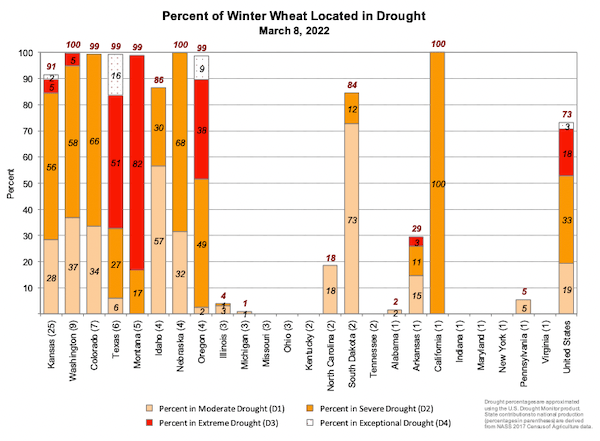The intensifying drought across U.S. winter wheat areas is raising more worries about a shortfall in global supplies this season. Currently, 73% of winter wheat production is within an area experiencing some sort of drought, compared to 69% at the beginning of February and 35% this same time last year.
The impact of the drought is evident in the poor crop conditions in key states of Kansas, Texas, and Oklahoma. Kansas is the biggest U.S. winter wheat producer. In its latest crop report released on March 14, USDA rated 23% of the Kansas winter wheat crop in good to excellent condition, down from 24% a week earlier and compared with 62% as of November 28. 38% of the crop is rated poor to very poor. For Texas, the No. 2 winter wheat state by planted area, just 6% of the crop is rated good to excellent, down from 7% the previous week and compared to 20% at the end of November. Oklahoma did see some improvement with 24% of the crop now in good to excellent condition, up from 15% the previous week. However, that’s substantially lower than 48% in November. USDA also warned in its latest Wheat Outlook report that much of the White wheat production in the Pacific Northwest is also experiencing a prolonged drought.
USDA notes that spring weather conditions will have a larger effect on the 2022 wheat crop and winter conditions alone are not a reliable determinant of harvest potential. The outlook could improve after the crop breaks dormancy in the spring. Winter wheat, which is harvested in June and July, makes up nearly half of total U.S. wheat production. While 2021 output rose a little over +9%, spring wheat production fell by -44% due to drought in the Northern Plains which is still ongoing. Spring wheat planting typically runs March to May and about 41% of the production area is currently within an area experiencing drought.
Winter wheat for 2022 is estimated to have been seeded on 34.4 million acres, up +2% from last year and the largest total since 2016/17 when farmers planted 36.15 million acres. This marks the second year in a row of increased winter wheat acreage after reaching the lowest level in 111 years in 2020/21. Hard Red Winter (HRW) wheat seeded area is expected to total 23.8 million acres, up +1% from 2021. The largest increases in planted acreage are estimated in Kansas and Texas where drought is impacting 91% and 99%, respectively, of winter wheat area. Soft Red Winter (SRW) wheat seeded area totals 7.07 million acres, up +6% from last year with the largest acreage increases expected in Missouri, North Carolina, and Ohio. White Winter wheat planted acreage is estimated to be up +2% from 2021.
Last year’s poor harvest helped push domestic wheat stocks to their lowest level since 2013/14. In its latest update, USDA lifted 2021/22 all-wheat ending stocks slightly to 653 million bushels but that is nonetheless -23% lower than last year and still the lowest since 2013/14. If drought conditions in the U.S. continue, the outlook could obviously deteriorate at the same time that global supplies are threatened due to the upheaval in Ukraine and Russia.







